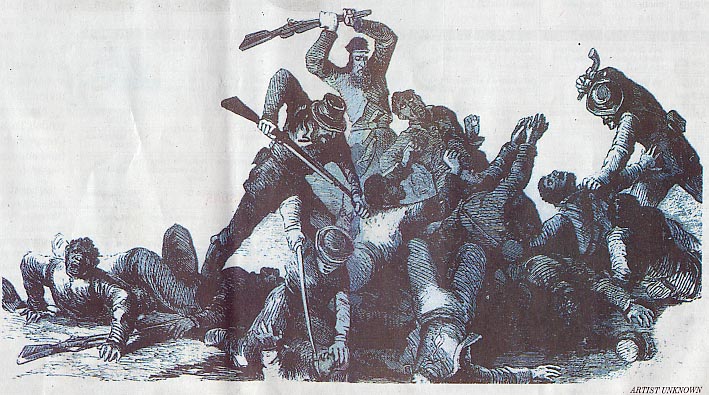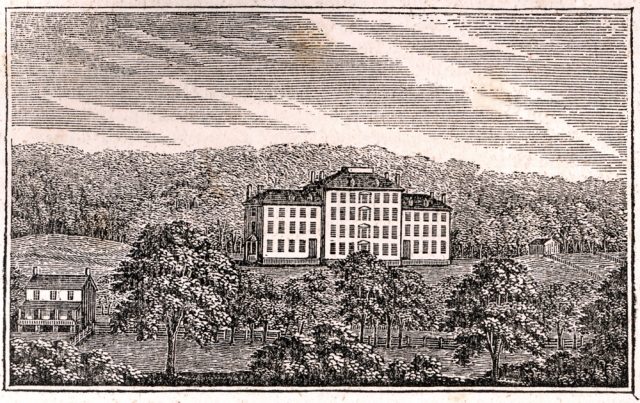They Intended To Kill All Of Them – Battle and Death in Southwest Virginia
150 years ago today, 5,000 Union soldiers marched toward Saltville, Virginia, aiming to destroy the key saltworks at that town. Under the command of Major General Stephen Burbridge, the forces were made up mostly of Kentucky Mounted Infantry, plus a regiment each of Ohio and Michigan Cavalry, and the 5th U.S. Colored Cavalry.
On the heights north and northeast of town, the Federals ran into 3,000 Confederate defenders, who received reinforcements throughout the battle. Burbridge launched repeated attacks against the Confederate positions, but failed to break their line in heavy fighting. The overall Southern commander, Major General John C. Breckinridge, arrived on the field late in the day, and directed the final defense as dusk settled over the battlefield. Burbridge retreated that night, leaving his wounded behind under flag of truce.
Despite the cloak of darkness, sporadic firing continued all during the night and into the morning. It came from Confederates, who had gone forward and were finishing off wounded black soldiers and plundering the Union dead. At dawn Breckinridge discovered what had happened and halted the killing. Accounts vary, but between a dozen and four dozen Union soldiers (mostly from the 5th U.S. Colored Cavalry) were murdered in cold blood.
But the Confederates were not done. Many wounded of both sides were evacuated to nearby Emory & Henry College, while the Confederate dead were buried in the college cemetery. Wiley Hall, the campus’s main building and today’s administrative headquarters, had been turned into a hospital.
On October 7 and 8, brigands under Champ Ferguson (who had fought at Saltville and participated in the killings) came to Emory & Henry. A Union surgeon described what happened next:
I would state that on Monday morning, October 3, there came to our field hospital several armed men, as I believe soldiers in the Confederate service, and took 5 men, privates, wounded (negroes), and shot them.
I would also further state that on Friday evening. October 7, at Emory and Henry College Hospital, Washington County, Va., to which place our wounded had been removed, several armed men entered the said hospital about 10 p. m. and went up into the rooms occupied by the Federal wounded prisoners, and shot 2 of them (negroes) dead in their beds.
I would further state that on Saturday, October 8, at Emory and Henry College Hospital, several armed men wearing the Confederate uniform and, as I believe, soldiers in the Confederate service, entered the same hospital about 4 p. m., overpowered the guard that had been placed there by the surgeon in charge, and went up into the rooms occupied by the Federal wounded prisoners, and shot Lieutenant E. C. Smith Thirteenth Regiment Kentucky Cavalry, dead in his bed, where he lay severely wounded. They at the same time called out for the other Federal officers confined there, particularly Colonel Hanson, Thirty-seventh Regiment Kentucky Volunteers, and Captain Degenfeld, Twelfth Ohio Cavalry, swearing that they intended to kill all of them; and I believe that they were only prevented doing so by the exertions of Surgeon Murfree, the surgeon, in charge the steward Mr. Acres, and the other attendants of the hospital. I would also further state that Surgeon Murfree the other surgeons, and the hospital attendants did all in their power even to the risk of their lives to prevent the perpetration of these outrages; and that they assisted in removing Colonel Hanson and Captain Degenfeld, as well as myself, to a place of safety.
Surgeon Murfree, his staff and attendants, and Mr. Acres were Confederate medical personnel. It appears the Federals’ only offense was having commanded and served with black soldiers.
This report came to light after the doctor’s exchange, and subsequently made it to the Secretary of War in Washington. It can be found here:
https://ehistory.osu.edu/books/official-records/077
After the war, Champ Ferguson was arrested, tried and hanged for these war crimes – only the second Confederate to earn this dubious distinction, along with Henry Wirz of Andersonville.
Today, Emory & Henry (the author’s alma mater) is a thriving college in Southwest Virginia. The searing memory of October 1864 is still there, not far below the surface. Several ghosts of Ferguson’s victims still roam Wiley Hall, seeking the peace they were denied in death.
Below: Wiley Hall, seen in 1850.

I probably wouldn’t have killed those wounded soldiers, but the mission they were on, destroying the salt works, was a war crime. The salt was necessary to preserve food for people who were literally starving, due to destruction of food, farms, farm animals, and transportation. The reason all prisoners caught on such missions weren’t killed was the ease with which Yankees could retaliate on helpless people. Yankees were much less likely to value their black soldiers so highly. Most military action is very hard on civilians, but salt destruction was criminal.
A war crime? Wasn’t there a war?
So where are these black soldier’s buried? I was told they were all killed in Saltville and buried in a mass grave. What about all the salt mines in the Great Lakes region? Did Saltville have another interest to the Union?
Good questions, Bobby. To my knowledge, that mass grave has never been precisely found. Saltville was one of the major centers of saltpeter refinement (for gunpowder) in the Confederacy; one study I read said that 85% of CS powder supplied to the armies wholly or partly came from there. Raiding Saltville was a major strike at the Confederate war effort.
Champ Ferguson was not an enlisted soilder for the south.The soilders buried at Emory died from sickness of different source.in Wiley Hall (206) of them.The mass grave at Saltville is rumored to be at Cedar Branch.Yes C. Ferguson was hanged.
To those asking about the graves, the men of the two Saltville raids were exhumed and reburied in Section B of the Knoxville National Cemetery after the war. I have been going through the records the last few days, and we know exactly which graves are the 292 burials from Saltville. One of the reburial reports states that one of the colored troops had been exhumed, his head severed from his body, and placed on a pike on the roadside in the aftermath of the Saltville Massacre. The man who did it was a civilian named Sam Huston.